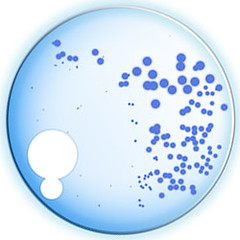Dave Taylor, Programme Lead, Virtual Worlds and Medical Media, and Robin Winter, 3D Interactive Designer, recently won the “design our avatar” competition.
You both work in the Medical Media and Design Laboratory (MMDL) at St Mary’s, within the Department of Surgery and Cancer. What work goes on within your lab?
 The lab provides consultancy and development services, and helps to support the Department’s research in use of virtual worlds for healthcare. Our applications range from hospital and service design planning, to major incident simulations for assessing communication and leadership skills. We work with other researchers in our Department, to make use of the latest research in behavioural science and the provision of information for patients in the NHS. Our most recent work focuses on the ability to walk through and test the design of a clinic and its services before it is even built. And we are beginning to work with specific patient communities, and researching more effective ways to help people lead healthier lives. There is an overview of some of our work in the Imperial Media library: http://www2.imperial.ac.uk/imedia/content/view/2084/new-media-and-healthcare-avatars-virtual-worlds-and-apps and in a BBC programme about our major incident simulations: http://www.rockhopper.tv/programmes/619/
The lab provides consultancy and development services, and helps to support the Department’s research in use of virtual worlds for healthcare. Our applications range from hospital and service design planning, to major incident simulations for assessing communication and leadership skills. We work with other researchers in our Department, to make use of the latest research in behavioural science and the provision of information for patients in the NHS. Our most recent work focuses on the ability to walk through and test the design of a clinic and its services before it is even built. And we are beginning to work with specific patient communities, and researching more effective ways to help people lead healthier lives. There is an overview of some of our work in the Imperial Media library: http://www2.imperial.ac.uk/imedia/content/view/2084/new-media-and-healthcare-avatars-virtual-worlds-and-apps and in a BBC programme about our major incident simulations: http://www.rockhopper.tv/programmes/619/
Picture: a photo of the Virtual Imperial Surgical Innovation Centre, based on the Paterson Centre in South Wharf Road on a misty day.
How is Second Life contributing towards student learning?
We have seen a slow but steady growth in the number of colleges and universities that have campuses or classes in Second Life but it is by no means a mainstream activity yet. We regularly support meetings and student projects that make use of the collaboration features of the virtual world, enabling students to co-operate and interact with other institutions across the globe. In the past month alone we’ve worked with learners that have logged in from South Africa, the United States and Canada.
Do you see this form of learning becoming more widely used over the coming years?
Second Life itself has plateaued recently but the open source equivalent, Opensimulator, continues to grow in popularity. And new developments such as 3D support in HTML5, emerging virtual world standards from the IEEE and the increasing popularity of gaming promise to speed up adoption in the future. You only have to speak to the people that take part in our research projects to realise the potential applications for this form of experiential learning. For example we are currently working on projects to help patients understand their treatment plans and service offerings.
You recently won our “design our avatar competition” for the @FoMImperial Twitter account. What impacts or benefits do you think Twitter and other Social Media are bringing to medical research and teaching communities?
 In an age where societies and economies are globally interconnected these technologies that permit the instantaneous exchange of ideas between individuals and institutions are central to almost every field. Second Life and Social Media generally have been used extensively by patients, and an increasing number of clinicians who wish to join-up with one another and with medical research and teaching communities around the globe. And with our International link-ups we are beginning to see how educators can reach out and work more directly with patients, students and research teams across the globe.
In an age where societies and economies are globally interconnected these technologies that permit the instantaneous exchange of ideas between individuals and institutions are central to almost every field. Second Life and Social Media generally have been used extensively by patients, and an increasing number of clinicians who wish to join-up with one another and with medical research and teaching communities around the globe. And with our International link-ups we are beginning to see how educators can reach out and work more directly with patients, students and research teams across the globe.
Key facts
- Job title: Dave Taylor, Programme Lead, Virtual Worlds and Medical Media / Robin Winter, 3D Interactive Designer
- Campus: St Mary’s Campus
- Building: QEQM
- More information